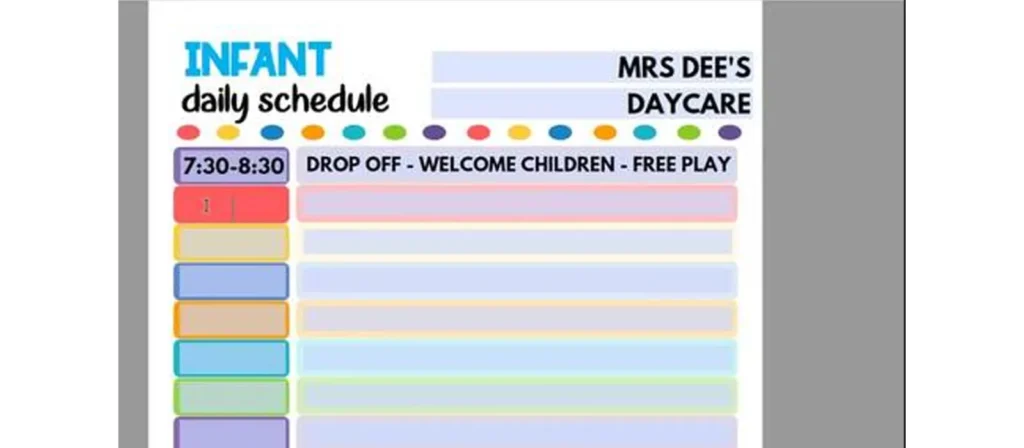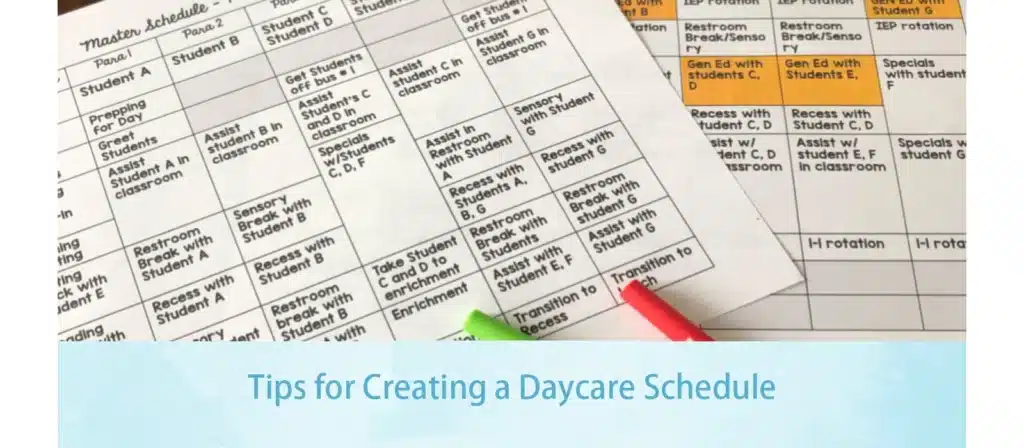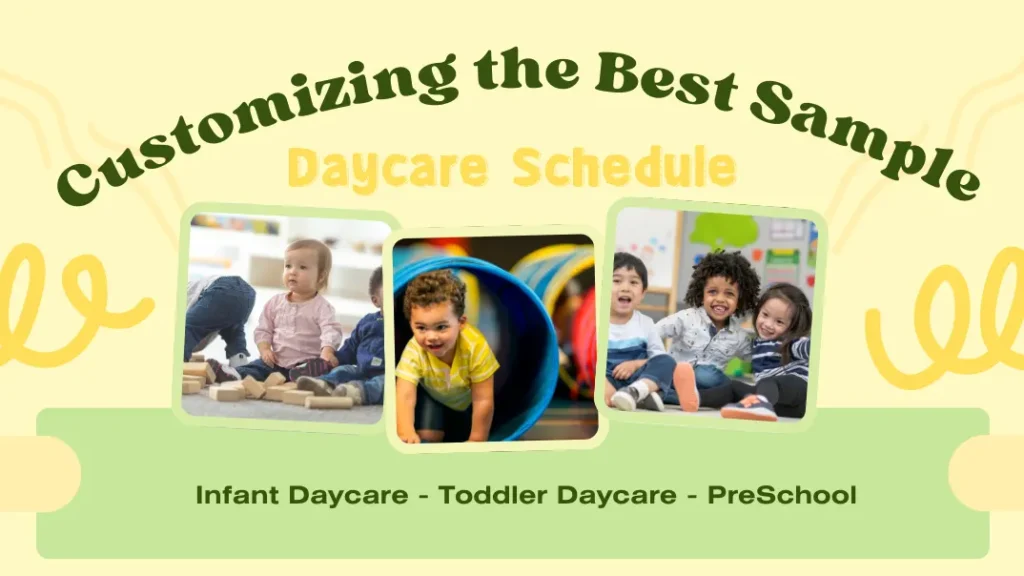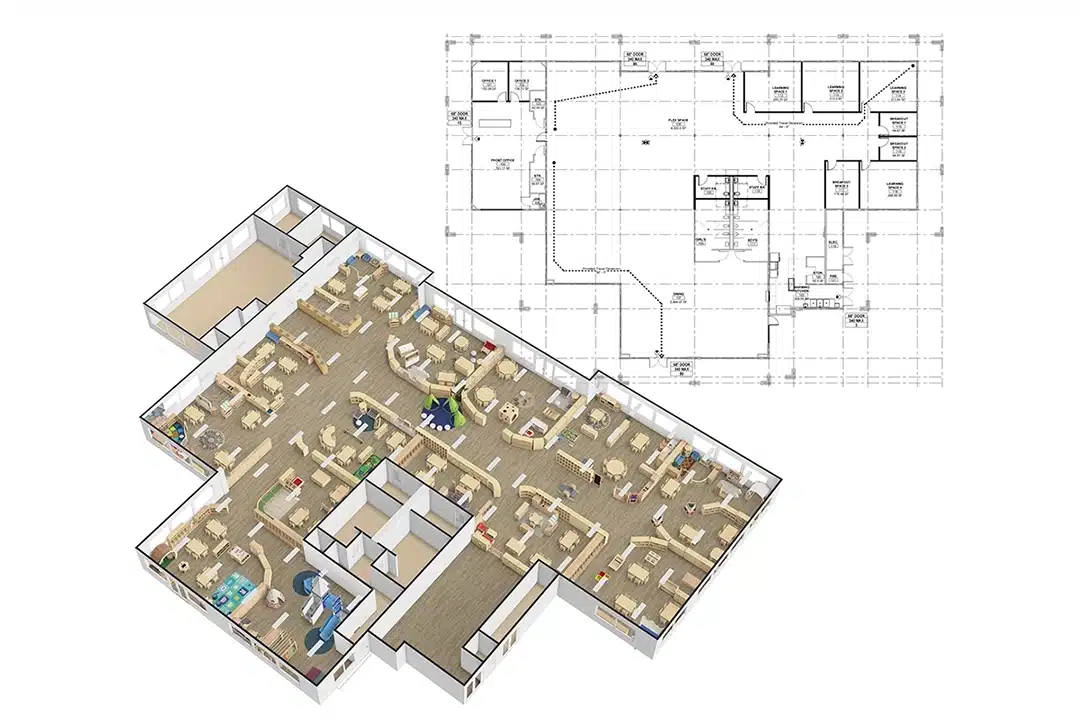Have you ever wondered how to create an effective and engaging daycare schedule? A schedule is one of the most important tools in any daycare setting. But what makes the best daycare schedule? How can it help foster both learning and development in children? What should a typical daycare schedule include to keep children engaged and safe throughout the day?
The best daycare schedule balances structured activities and free play. By ensuring a consistent routine, children feel safe and can predict what comes next, promoting better learning and emotional development. A well-planned daycare schedule incorporates physical activities, cognitive learning, mealtime, and rest periods to support the developmental needs of young children.
Creating the ideal daycare schedule requires understanding child development, balancing various types of activities, and ensuring the environment is suitable for their needs. In this article, I will walk you through customizing a daycare schedule that promotes optimal growth.
What is a Daycare Schedule?
A daycare schedule is a structured plan that outlines the daily activities, meals, nap times, and learning experiences provided to children in daycare. It’s designed to ensure children receive a balanced combination of play, rest, and learning, creating a routine that supports their physical, emotional, and cognitive growth. A well-organized schedule also helps daycare providers maintain order, reducing stress for children and caregivers while fostering a nurturing environment for the kids to thrive.

Daycare Schedule Basics
A daycare schedule is more than just a list of activities. It should account for age group, developmental milestones, and each child’s physical and emotional needs. Some basic components to consider when designing a daycare schedule include:
- Arrival and Free Play: Children need time to adjust and explore their environment before structured activities begin.
- Meals and Snacks: Regular meal times ensure that children are well-fed and energized for the day ahead.
- Rest and Nap Times: These are essential for physical and mental recovery, particularly for younger children.
- Learning Activities: Structured learning experiences like arts and crafts or circle time help foster cognitive development.
- Outdoor Play: Fresh air and physical exercise are crucial for children’s physical and social growth.
- Pick-Up Time: At the end of the day, you should have time to wind down and reflect on the day’s activities.
Benefits of Establishing a Daycare Schedule
Establishing a daycare schedule offers multiple benefits, including:
- Consistency and Security: A routine provides children with a sense of security, knowing what to expect next, which is especially important for younger children.
- Promotes Healthy Development: A balanced schedule that includes a mix of activities ensures that children’s developmental needs, from physical activity to cognitive stimulation, are met.
- Improved Behavior: Children with structured routines tend to exhibit fewer behavioral issues because they know what’s expected and when.
- Efficient Use of Time: A set schedule helps caregivers make the most of each day by ensuring activities are well-planned and nothing is missed.
- Time for Learning and Rest: Ensuring an appropriate balance between structured activities and rest periods helps children remain engaged without feeling overstimulated or exhausted.
- Increased learning: With structured times for creative activities, children can engage in focused learning experiences.

Infant Daycare Schedule
Regarding infant daycare schedules, it’s essential to prioritize rest, feeding, and sensory development. Babies need a lot of sleep and nurturing care at this stage, so flexibility is key. Let’s explore the milestones infants typically hit in the first year and how they influence daycare routines.
Infant Physical Development Milestones
Infants undergo rapid physical development in their first year, including major milestones such as:
- Head control: Around 1–2 months, babies begin to lift their heads during tummy time.
- Rolling over: By 4–6 months, many infants start rolling from front to back or vice versa.
- Sitting up: By 6 months, babies may sit up unsupported for short periods.
- Crawling: Around 7–9 months, infants begin crawling, which leads to more exploration.
- Walking: Some infants begin walking by 12 months, while others may take longer.
Infant daycare schedules should allow ample tummy time, physical exploration, and sleep.
Infant Social/Emotional Development Milestones
Infants also experience key social and emotional milestones, such as:
- Social smiles: Babies respond to social interaction around 6–8 weeks.
- Stranger anxiety: Typically begins around 6–8 months when babies start recognizing familiar faces.
- Separation anxiety: As infants grow, they may experience separation anxiety around 8–12 months, making it important for caregivers to offer comfort and reassurance.
A well-paced schedule helps babies feel secure, especially when transitioning between activities.
Infant Language Development Milestones
Infants begin their language journey through the following:
- Cooing and babbling: Babies start cooing at 2–3 months and may begin babbling by 4–6 months.
- Understanding simple words: By 9–12 months, infants may start to understand simple words like “mama” or “no.”
- Gestures: Babies often use gestures such as waving or pointing as early as 9 months.
Daycare routines should incorporate language-rich activities like talking, reading, and singing.
Sample Infant Daycare Schedule
| Time | Activity |
|---|---|
| 7:30 AM – 8:00 AM | Arrival and Settling In |
| 8:00 AM – 8:30 AM | Morning Feeding |
| 8:30 AM – 9:00 AM | Tummy Time / Movement Activities |
| 9:00 AM – 9:30 AM | Playtime (Sensory Play) |
| 9:30 AM – 10:00 AM | Storytime or Sing-Along |
| 10:00 AM – 10:30 AM | Nap / Rest Time |
| 10:30 AM – 11:00 AM | Snack Time |
| 11:00 AM – 12:00 PM | Outdoor Exploration / Walk |
| 12:00 PM – 12:30 PM | Lunch and Feeding |
| 12:30 PM – 1:30 PM | Nap / Rest Time |
| 1:30 PM – 2:00 PM | Interactive Play or Music Time |
| 2:00 PM – 3:00 PM | Independent Play / Social Interaction |
| 3:00 PM – 3:30 PM | Afternoon Snack |
| 3:30 PM – 4:00 PM | Wind-Down Activities (Quiet Play) |
| 4:00 PM – 5:00 PM | Pick-Up Time |

Toddler Daycare Schedule
Daycare schedules for toddlers need to balance structure with flexibility. Toddlers are more active and at a stage where physical and social interactions become increasingly important.
Toddler Physical Development Milestones
Toddlers typically reach the following milestones:
- Walking and running: By 12–18 months, toddlers are walking confidently and may begin to run.
- Climbing: Toddlers often enjoy climbing and exploring their environment.
- Fine motor skills: They begin to develop fine motor skills, such as stacking blocks, drawing, or feeding themselves.
Daycare schedules should include ample outdoor time and opportunities for active play.
Toddler Social/Emotional Development Milestones
Key social and emotional milestones include:
- Independence: Toddlers assert their independence and may say “no” or “mine.”
- Parallel play: Toddlers often play parallel, playing near but not directly with others.
- Emotional regulation: They begin recognizing and expressing their emotions, although tantrums are common.
A flexible routine helps toddlers navigate their emotions and build social skills.
Toddler Language Development Milestones
Language development during the toddler years includes:
- Vocabulary explosion: Between 18–24 months, toddlers rapidly expand their vocabulary.
- Simple sentences: By age 2, many toddlers start using 2-3 word sentences.
- Imitating speech: Toddlers love imitating adults and peers, which enhances their language skills.
Sample Toddler Daycare Schedule
| Time | Activity |
|---|---|
| 7:30 AM – 8:00 AM | Arrival and Free Play |
| 8:00 AM – 8:30 AM | Breakfast |
| 8:30 AM – 9:00 AM | Structured Play (Blocks, Puzzles) |
| 9:00 AM – 9:30 AM | Circle Time and Songs |
| 9:30 AM – 10:00 AM | Outdoor Play (Running, Climbing) |
| 10:00 AM – 10:30 AM | Snack Time |
| 10:30 AM – 11:00 AM | Learning Activity (Colors, Numbers) |
| 11:00 AM – 12:00 PM | Free Play and Social Interaction |
| 12:00 PM – 12:30 PM | Lunch |
| 12:30 PM – 1:30 PM | Nap Time |
| 1:30 PM – 2:00 PM | Sensory Play or Art Time |
| 2:00 PM – 3:00 PM | Outdoor Walk or Group Games |
| 3:00 PM – 3:30 PM | Afternoon Snack |
| 3:30 PM – 4:00 PM | Wind-Down Activities (Books, Quiet Time) |
| 4:00 PM – 5:00 PM | Pick-Up Time |

Preschool Schedule
By the time children reach preschool, they are more capable of handling structured learning activities, and the daycare schedule should reflect this.
Preschooler Physical Development Milestones
Preschoolers experience physical development milestones like:
- Mastering basic motor skills: Preschoolers refine their motor skills, including hopping, skipping, and balancing.
- Improved coordination: They begin participating in more complex physical activities like climbing and ball games.
Daycare schedules should include ample indoor and outdoor physical activity opportunities.
Preschooler Social/Emotional Development Milestones
Preschoolers also experience important social milestones, including:
- Group play: Preschoolers engage more in cooperative play, sharing, and taking turns.
- Empathy: They begin to show empathy and understand how others feel.
- Emotion regulation: Preschoolers start managing their emotions better, though they may still need help during moments of frustration.
A consistent schedule helps them develop social and emotional intelligence in a group setting.
Preschooler Language Development Milestones
Key language milestones for preschoolers include:
- Complex sentences: Preschoolers start speaking in longer, more complex sentences.
- Storytelling: They love telling stories and may start to create their narratives.
- Pre-literacy skills: Many preschoolers begin recognizing letters, numbers, and words.
A daycare schedule should incorporate activities like storytelling, writing, and group discussions.
Sample Preschool Daycare Schedule
| Time | Activity |
|---|---|
| 7:30 AM – 8:00 AM | Arrival and Independent Play |
| 8:00 AM – 8:30 AM | Breakfast |
| 8:30 AM – 9:00 AM | Morning Circle Time and Songs |
| 9:00 AM – 9:30 AM | Learning Activity (Shapes, ABCs) |
| 9:30 AM – 10:00 AM | Outdoor Play (Obstacle Course, Sports) |
| 10:00 AM – 10:30 AM | Snack Time |
| 10:30 AM – 11:00 AM | Storytime or Group Discussion |
| 11:00 AM – 12:00 PM | Creative Play (Art, Crafts) |
| 12:00 PM – 12:30 PM | Lunch |
| 12:30 PM – 1:30 PM | Nap or Quiet Time |
| 1:30 PM – 2:00 PM | Science or Discovery Activity |
| 2:00 PM – 3:00 PM | Free Play and Social Interaction |
| 3:00 PM – 3:30 PM | Afternoon Snack |
| 3:30 PM – 4:00 PM | Reflection and Sharing Time |
| 4:00 PM – 5:00 PM | Pick-Up Time |

Outdoor Day Care Schedule
Outdoor activities play a vital role in fostering physical, social, and emotional development in children. An outdoor daycare schedule allows children to explore their surroundings, burn off energy, and practice motor skills. Here’s an example of an Outdoor Daycare Schedule that balances structured activities with free exploration:
Sample Outdoor Day Care Schedule
| Time | Activity |
|---|---|
| 8:00 AM – 8:30 AM | Arrival and Settling In |
| 8:30 AM – 9:00 AM | Outdoor Free Play (Running, Climbing) |
| 9:00 AM – 9:30 AM | Circle Time and Outdoor Songs |
| 9:30 AM – 10:00 AM | Group Games (Tag, Obstacle Course) |
| 10:00 AM – 10:30 AM | Snack Time |
| 10:30 AM – 11:00 AM | Nature Exploration (Walk, Observing Animals) |
| 11:00 AM – 11:30 AM | Creative Outdoor Play (Drawing, Crafting with Nature) |
| 11:30 AM – 12:00 PM | Group Discussion (What Did We See?) |
| 12:00 PM – 12:30 PM | Lunch Time |
| 12:30 PM – 1:30 PM | Quiet Outdoor Play / Storytime |
| 1:30 PM – 2:00 PM | Free Play (Sandbox, Building Blocks) |
| 2:00 PM – 2:30 PM | Afternoon Snack and Relaxation |
| 2:30 PM – 3:00 PM | Goodbye Circle and Wind-Down Time |

Tips for Creating a Developmentally Appropriate Daily Schedule
Creating a daycare schedule that supports children’s growth requires thoughtful planning. Here are some essential tips for customizing the schedule to meet developmental needs:
1. Establish Consistent Rituals
Children thrive on routine and consistency. Daily rituals, such as greeting children at the door or having a consistent bedtime story, help them feel secure and confident. Consistent routines reduce anxiety and build trust, which is essential for emotional development.
2. Meet Individual Needs
Every child is unique, and daycare schedules should be flexible enough to accommodate individual needs. Some children may need more nap time, while others require more active play. Observe each child’s behavior and adjust the schedule to ensure they get the most out of their daycare experience.
3. Create Physical, Social, and Emotional Growth Experiences
Ensure the schedule balances physical play, social interaction, and emotional development. Activities like cooperative games, arts and crafts, and group discussions foster communication and empathy, while physical activities like running and climbing help develop motor skills.
4. Allow Lots of Free Play
Unstructured free playtime fosters creativity, problem-solving, and social skills. Allow children to choose their activities during certain parts of the day to encourage independence and decision-making. This helps them develop confidence and learn through exploration.
5. Provide Transition Time
Transitions between activities can be difficult for younger children. Allow enough time for children to adjust to each change—moving from outdoor play to lunchtime or transitioning into rest time. Gradual transitions prevent meltdowns and help children feel more comfortable with the routine.

How to Optimize Your Day Care Schedule
Optimizing a daycare schedule goes beyond just creating one. It’s about continuously improving and adapting the routine to ensure that children and caregivers get the most out of each day. Here are some ways to optimize your daycare schedule:
1. Track Daily Attendance
Tracking attendance ensures that every child’s needs are met. It also allows caregivers to notice patterns and adjust schedules to accommodate children’s preferences and energy levels.
2. Track Employee Work and Break Time
Efficient staff scheduling is just as important as the child schedule. Track staff hours to ensure enough time for breaks, preparation, and interaction with the children.
3. Centralize Communication
Use digital tools or communication boards to centralize important information, including updates about the daily schedule, activities, or special events. This allows for smooth communication between caregivers, parents, and management.
4. Be Consistent
Consistency is key to an effective daycare schedule. Stick to the established routine as much as possible to provide children with the needed stability. While flexibility is important, children thrive on predictability.
FAQs
- How often should I adjust my daycare schedule?
Reviewing your daycare schedule regularly is essential, especially when there are noticeable changes in the children’s behavior, interests, or developmental milestones. Adjustments should be made based on individual needs and seasonal changes. - What is the best way to manage a daycare schedule for children of different ages?
Group children by age or developmental level and structure activities accordingly. Ensure each group has a routine that suits their specific needs, with plenty of flexibility built in. - How can I ensure my daycare schedule is balanced?
Balance structured activities (like learning and group play) with free play and rest periods. A varied routine promotes healthy physical, emotional, and cognitive development. - What are the key components of a daycare schedule?
The essential components of a daycare schedule include arrival and free play, structured activities, meals, snacks, naps, and outdoor play. Each element should support the child’s developmental needs. - What should I do if a child resists the daycare schedule?
If a child resists the schedule, try to understand the root cause. They may be tired, overstimulated, or anxious. Modify the schedule slightly to accommodate their needs or offer more comfort during transitions. - How can I keep the daycare schedule flexible yet structured?
Allow room for unplanned moments like extra playtime or breaks, but keep a basic structure in place. This ensures children feel secure and maintain focus, while still allowing for spontaneity. - What should be the ideal nap time for toddlers and preschoolers in daycare?
Toddlers typically need 1.5-2 hours of nap time, while preschoolers may require 1-1.5 hours to recharge for the rest of the day. - Can daycare schedules help with emotional development?
Yes! A structured schedule gives children a sense of security, routine, and predictability, vital for emotional growth. - Can I customize a daycare schedule to fit my child’s needs?
Absolutely! Parents and caregivers can work together to adjust nap times, learning activities, and play sessions to accommodate each child’s preferences and developmental stage.
Conclusion
Creating the best daycare schedule for your child is essential in providing a smooth, enriching experience at daycare. By considering your child’s unique needs, adjusting the schedule as necessary, and staying flexible, you can ensure your child’s time at daycare is both enjoyable and beneficial. Whether you’re a parent customizing your child’s schedule or a daycare provider seeking a sample routine, remember that consistency and care are key to a successful daycare experience.












